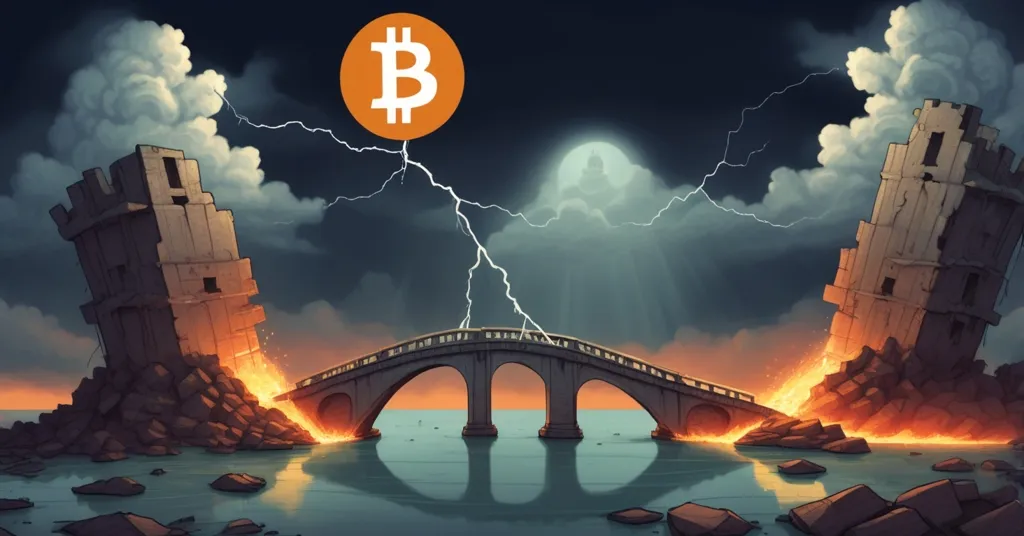Trump’s Indo-Pacific Policy Shakes Alliances, Strengthens Bitcoin’s Case

Trump’s Transactional Gambit: Undermining Indo-Pacific Ties and Boosting the Case for Bitcoin
President Donald Trump’s foreign policy is sending shockwaves through the Indo-Pacific, with US-India relations crumbling to a historic low while ties with China show unexpected warmth. Analysts warn that Trump’s short-sighted, deal-driven approach risks dismantling decades of strategic alliances, potentially pushing India toward rival powers. Amid this geopolitical turmoil, decentralized systems like Bitcoin and blockchain technology emerge as compelling alternatives for financial resilience against trade wars and state-controlled economic weapons.
- US-India Relations Tank: Punitive tariffs and diplomatic blunders strain a once-strong partnership.
- US-China Thaw: Reduced tariffs and military talks with Beijing contrast sharply with India’s treatment.
- Bitcoin’s Opening: Geopolitical chaos underscores the need for decentralized financial tools.
US-India Partnership in Freefall
The bond between Washington and New Delhi hasn’t been this fractured in years, with trust between the two nations described as utterly shattered. Back in August, the US imposed a crushing 50% tariff on Indian goods—think of it as a steep extra tax that makes everything from Indian steel to textiles far pricier for American buyers. On top of that, an additional 25% penalty was slapped on due to India’s oil purchases from Russia, bringing the total to a jaw-dropping 75% in some cases. This isn’t just a number; it’s a gut punch to Indian exporters and businesses already navigating global headwinds. Meanwhile, Chinese goods face a lighter 47% tariff after recent reductions, a disparity that’s hard to ignore.
Adding insult to injury, the US introduced a $100,000 fee for H1B work visas, a move that directly hits Indian tech professionals and companies integral to the American economy. These visas have long been a lifeline for skilled workers, especially from India’s booming IT sector, fueling Silicon Valley’s innovation. Now, this financial barrier feels like a deliberate snub. And then there’s Trump’s loud claims of playing mediator in India-Pakistan conflicts, boasting he’s stepped in to stop fighting and even threatening 250% tariffs on both nations if they didn’t comply. These statements aren’t just diplomatic faux pas—they’ve become ammunition for Indian opposition leaders like Rahul Gandhi, who’ve accused Prime Minister Narendra Modi of cowering under Trump’s shadow, stoking domestic unrest.
“Getting back the trust between the two nations could take years to rebuild,” cautioned Atman Trivedi, a South Asia expert at DGA-Albright Stonebridge Group.
Historically, the US-India alliance has been a bedrock of American foreign policy since the late 1990s, carefully built by past administrations as a democratic counterweight to China’s growing clout in Asia. India’s tech industry and shared democratic values tied it closely to the US economy, making it a key partner in maintaining regional stability. But under Trump’s watch, this strategic vision seems to have been traded for quick economic wins, leaving a void where trust once stood.
US-China Warming: A Strategic Misstep?
While India reels from trade penalties, the US appears to be extending an olive branch to China. Following a recent meeting between Trump and Chinese President Xi Jinping in South Korea, tariffs on Chinese goods linked to fentanyl production were cut from 20% to 10%. Military-to-military communication channels were also opened to de-escalate tensions—a stark contrast to the cold shoulder India’s receiving. This shift raises eyebrows, especially when you consider the broader context of the Indo-Pacific strategy, a US-led effort to ensure a free and open region in Asia and the Pacific, often through alliances like the Quad, which includes the US, India, Japan, and Australia.
“Trump clearly does not see India as useful for keeping China in check the way earlier presidents did,” observes Raymond Vickery Jr., an analyst at the Center for Strategic and International Studies.
At the personal level, the rapport between leaders is notably absent with India, unlike the apparent ease in US-China dialogue. This disconnect isn’t just symbolic—it’s a fracture in a partnership meant to balance power in a volatile region. As Trivedi pointed out to CNBC, the missing chemistry between leaders could have profound effects on the entire US-India relationship, effects that might ripple across global alliances.
Indo-Pacific Strategy on Thin Ice
The broader implications of Trump’s transactional focus are alarming for the Indo-Pacific region. The risk isn’t just a strained bilateral relationship—it’s the potential realignment of global powers. Analysts warn that pushing India away could drive it closer to Russia, China, or the Global South, a loosely aligned group of developing nations often at odds with Western dominance. India’s continued oil purchases from Russia, despite Western sanctions over Ukraine, already complicate its position, and the additional 25% US tariff only deepens the wedge. A pivot toward Moscow or Beijing isn’t just speculation; it’s a strategic fallback for a nation feeling cornered, as highlighted by experts analyzing Trump’s approach to the Indo-Pacific strategy.
“The Trump policy will push India further toward Russia, the Global South, and even China. This will not be in the interests of either India or the US,” Vickery warns bluntly.
Amid this mess, there’s a faint glimmer of cooperation. A 10-year “Framework for the US-India Major Defence Partnership” was signed, focusing on coordination, information sharing, and technology collaboration. Indian Defense Minister Rajnath Singh emphasized its importance for regional stability, calling it critical for ensuring a free, open, and rules-based Indo-Pacific. Yet, this defense deal feels like a Band-Aid on a gaping wound—unlikely to offset the economic and political damage already done. If anything, it highlights the stark contrast between military commitments and the broader erosion of trust.
Decentralized Finance as a Lifeline
Bitcoin’s Role in Trade Disputes
Let’s cut to the chase: when governments weaponize trade with tariffs and visa fees, businesses and individuals get caught in the crossfire. This is where Bitcoin steps up to the plate, offering a middle finger to state-controlled financial chokeholds. Unlike traditional money, Bitcoin operates as a digital currency that doesn’t rely on any government or bank, allowing direct transactions across borders without interference. Imagine an Indian exporter dodging punitive tariffs by settling payments in BTC, bypassing banking channels that inflate costs. It’s not just theory—nations like El Salvador have already adopted Bitcoin as legal tender, using it to sidestep economic pressures from global trade dynamics. For India, with its massive remittance inflows and export markets, Bitcoin could be a hedge against geopolitical gamesmanship.
DeFi’s Niche Solutions
Beyond Bitcoin, decentralized finance—or DeFi—built on platforms like Ethereum, offers unique tools for resilience. Ethereum’s smart contracts, essentially self-executing agreements coded on the blockchain, can automate trade deals or remittances without middlemen. Picture an Indian tech worker in the US using stablecoins—cryptocurrencies pegged to fiat like the US dollar—on Ethereum to send money home, avoiding visa fee fallout or currency fluctuations. DeFi protocols fill niches Bitcoin doesn’t, providing programmable financial solutions for complex needs. While Bitcoin maximalists might scoff, altcoins and DeFi systems are carving out practical use cases, especially in a trade-war-torn landscape where trust in centralized systems is crumbling.
India’s Crypto Conundrum: Adoption vs. Regulation
India’s relationship with crypto is a rollercoaster. On one hand, platforms like WazirX report over 10 million users as of recent years, a testament to grassroots hunger for alternatives amid economic uncertainty. On the other, the government’s stance is a buzzkill—a 30% tax on crypto gains and a 1% tax deducted at source on transactions make trading a pricey affair. These rules, while legitimizing crypto as a taxable asset, stifle mainstream adoption. Back in 2018, the Reserve Bank of India tried banning crypto outright, only for the Supreme Court to overturn it in 2020. Today, as trade policies tighten the screws, the question looms: will India ease up on crypto to empower its citizens, or double down on control? The potential for blockchain-based cross-border trade is massive, but regulatory roadblocks keep it a distant dream for many.
Counterpoints: Bitcoin and DeFi Aren’t Magic Bullets
Before we drown in optimism, let’s get real—Bitcoin and DeFi aren’t ready to overhaul global trade overnight. Bitcoin struggles to handle millions of transactions quickly, unlike traditional payment systems, though solutions like the Lightning Network are chipping away at this scalability snag. Its price volatility is another beast; one day you’re up 20%, the next you’re down 15%, hardly a stable store of value for exporters or workers. DeFi, while innovative, often faces security risks—hacks on Ethereum protocols have cost millions, and the learning curve for using these tools is steep for the average user.
Moreover, decentralized systems don’t fix the root geopolitical tensions. Tariffs, alliances, and power plays won’t vanish because you’ve got a Bitcoin wallet. They’re a bandage, not a cure, and even then, only for those tech-savvy enough to navigate the space. While Bitcoin maximalists might argue it’s the ultimate escape from fiat tyranny, altcoins and Ethereum-based solutions deserve credit for tackling niche problems Bitcoin can’t—like automated contracts for trade. Sure, decentralized tech isn’t perfect, but compared to fiat systems buckling under political whims, it’s a damn good start.
The Road Ahead
Zooming out, Trump’s transactional foreign policy is reshuffling the Indo-Pacific chessboard, alienating a key ally like India while cozying up to China. The risk of India pivoting toward Russia or the Global South looms large, threatening both US and Indian strategic goals. Amid this chaos, the case for decentralized systems grows stronger—Bitcoin and blockchain tech offer a glimpse of financial autonomy when governments turn trade into a battlefield. If tariffs and policies can cripple economies overnight, shouldn’t we rethink who controls our money? The future isn’t certain, but as trust in centralized systems frays, the appeal of trustless alternatives only sharpens. Keep an eye on how nations like India navigate this storm—and whether blockchain carves out a bigger role in dodging the fallout.
Key Questions and Takeaways
- How are Trump’s policies damaging US-India relations?
Harsh tariffs up to 75% on Indian goods, a $100,000 H1B visa fee, and provocative claims about mediating India-Pakistan conflicts have shattered trust, with recovery potentially taking years. - Why is the US favoring China over India?
Post a South Korea meeting, Trump cut Chinese tariffs and opened military dialogue, prioritizing short-term deals over India’s strategic role as a counter to Beijing’s influence. - What’s at risk for the Indo-Pacific region?
A transactional US approach could push India toward Russia, China, and the Global South, undermining shared goals for a free and open regional order. - How can Bitcoin help in this geopolitical mess?
Bitcoin offers a borderless way to settle payments and store value, potentially helping businesses and individuals dodge trade penalties and fiat instability. - What role do DeFi and altcoins play?
Ethereum-based DeFi provides niche tools like smart contracts for automated trade and remittances, complementing Bitcoin’s strengths in specific use cases. - Are there limits to crypto as a solution?
Absolutely—scalability, volatility, and regulatory hurdles mean Bitcoin and DeFi aren’t full fixes, just resilient alternatives to flawed systems. - Can the US-India defense deal save the partnership?
The 10-year agreement is a positive step for regional stability, but economic and political frictions likely overshadow its impact for now.



